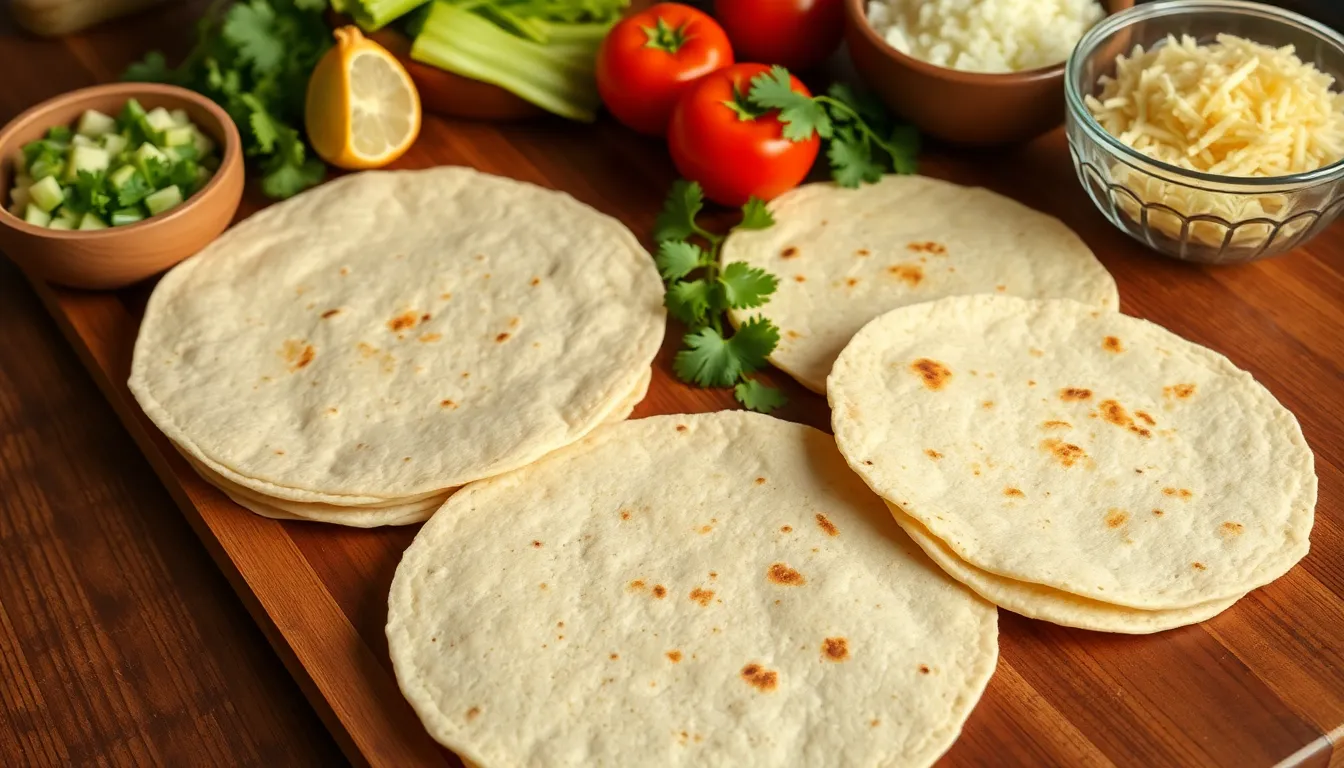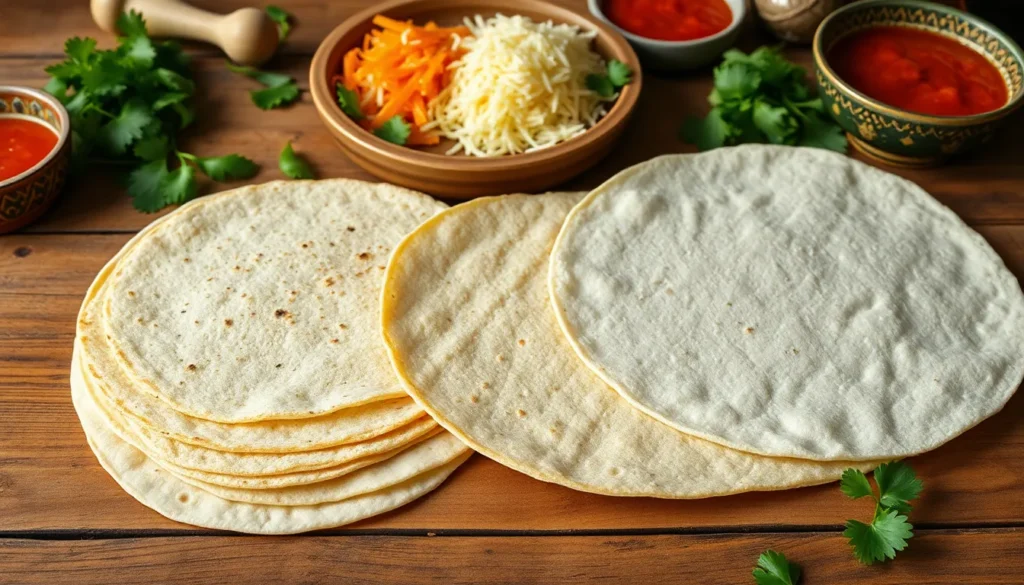When it comes to enchiladas, the right size tortilla can make or break the dish. Picture this: a perfectly rolled enchilada bursting with flavor, or a sad, floppy mess that just won’t hold together. It’s a culinary tragedy waiting to happen! Knowing what size tortillas to use is like having the secret sauce to success.
Table of Contents
ToggleUnderstanding Tortilla Sizes
Selecting the appropriate tortilla size is essential for crafting delicious enchiladas. The right dimensions help maintain structural integrity and enhance flavors.
Common Tortilla Sizes
Common tortilla sizes include 6-inch, 8-inch, 10-inch, and 12-inch varieties. Typically, chefs opt for 8-inch tortillas for standard enchiladas. Smaller tortillas serve well for bite-sized appetizers. Larger tortillas accommodate heartier fillings, allowing for better rolling. Each size correlates to the amount of filling used, affecting both taste and presentation.
Factors Influencing Tortilla Size
Several factors influence the choice of tortilla size for enchiladas. The type of filling plays a significant role; denser fillings require larger tortillas to prevent tearing. Personal preferences matter too; some people enjoy larger, stuffed enchiladas while others prefer smaller portions. Dietary considerations, like portion control, can also dictate size choices. Lastly, the occasion impacts decisions, with family gatherings often calling for larger tortillas or multiple varieties.
Best Tortilla Sizes for Enchiladas

Selecting the right tortilla size enhances the overall enchilada experience. The appropriate size ensures a balance of flavors and textures.
Standard Sizes for Enchiladas
The most common tortilla size for enchiladas is 8 inches. This size allows chefs to create perfectly rolled enchiladas without them falling apart. Smaller options, such as 6 inches, work well for bite-sized appetizers and children’s portions. Conversely, 10-inch and 12-inch tortillas accommodate heartier fillings, making them ideal for larger servings. Larger tortillas also allow for more variety in fillings, appealing to varying tastes. Using standard sizes ensures consistency when preparing enchiladas for gatherings or special occasions.
Considerations for Size Selection
Several factors influence tortilla size selection. The type of filling significantly affects the choice; richer, chunkier fillings benefit from larger tortillas. Personal preferences also play a role; some diners prefer more manageable portions, while others enjoy generous servings. Dietary considerations, like gluten-free options, may limit size options, though 8-inch tortillas generally remain a versatile choice. Additionally, the occasion impacts size; family gatherings typically call for larger tortillas, while casual meals may suit smaller ones. Balancing these factors leads to a successful enchilada preparation.
Tortilla Type and Its Impact on Size
Tortilla type significantly influences size selection for enchiladas. Choosing between flour and corn affects the overall texture and taste of the dish.
Flour Tortillas vs. Corn Tortillas
Flour tortillas tend to be larger and softer, measuring 10 to 12 inches. These tortillas hold up well with heavier fillings, making them ideal for hearty enchiladas. Corn tortillas typically range from 6 to 8 inches, offering a firmer texture. These smaller tortillas provide a distinctive flavor that complements lighter fillings. A chef may prefer flour for rich, meaty enchiladas while choosing corn for traditional recipes with vegetables or cheese.
Specialty Tortillas
Specialty tortillas include options like spinach, whole wheat, or gluten-free varieties. These tortillas often come in standard sizes, such as 8 or 10 inches, but offer unique flavor profiles and dietary options. Chefs may select them to accommodate guests with dietary restrictions or to add a twist to classic enchiladas. Using specialty tortillas can enhance presentation while allowing for creativity in flavor combinations, catering to diverse preferences.
Tips for Preparing Enchiladas
Preparation techniques play a vital role in creating delicious enchiladas.
Techniques for Rolling Enchiladas
Begin by softening tortillas in a warm skillet or microwave. This step adds flexibility, making it easier to roll without breaking. Next, place an appropriate amount of filling, usually about ¼ to ⅓ cup, along one edge of the tortilla. Carefully roll the tortilla away from you while tucking in the sides as you go. Position the seam side down in the baking dish to secure the rolls. Utilizing this technique consistently ensures enchiladas stay intact during cooking.
Ideal Amount of Filling
Filling amounts depend on tortilla size and type. For 8-inch tortillas, ¼ cup of filling typically creates a balanced dish. Ensure the filling mixture is moist but not overly wet, preventing sogginess. Overfilling leads to breakage and messy presentation. Adjust amounts for larger (10 to 12 inches) or smaller tortillas (6 inches) accordingly. Aim for a harmonious balance between flavor and texture for optimal enjoyment.
Choosing the right tortilla size is essential for crafting delicious enchiladas. The 8-inch tortilla stands out as the most versatile option for achieving the perfect balance of flavors and textures. It’s crucial to consider the type of filling and personal preferences when selecting tortilla sizes. Larger tortillas can accommodate heartier fillings while smaller ones are great for lighter options or children’s portions.
By understanding these factors and employing proper preparation techniques, anyone can elevate their enchilada game. Ultimately, the right tortilla size leads to a satisfying culinary experience that brings joy to the table.





